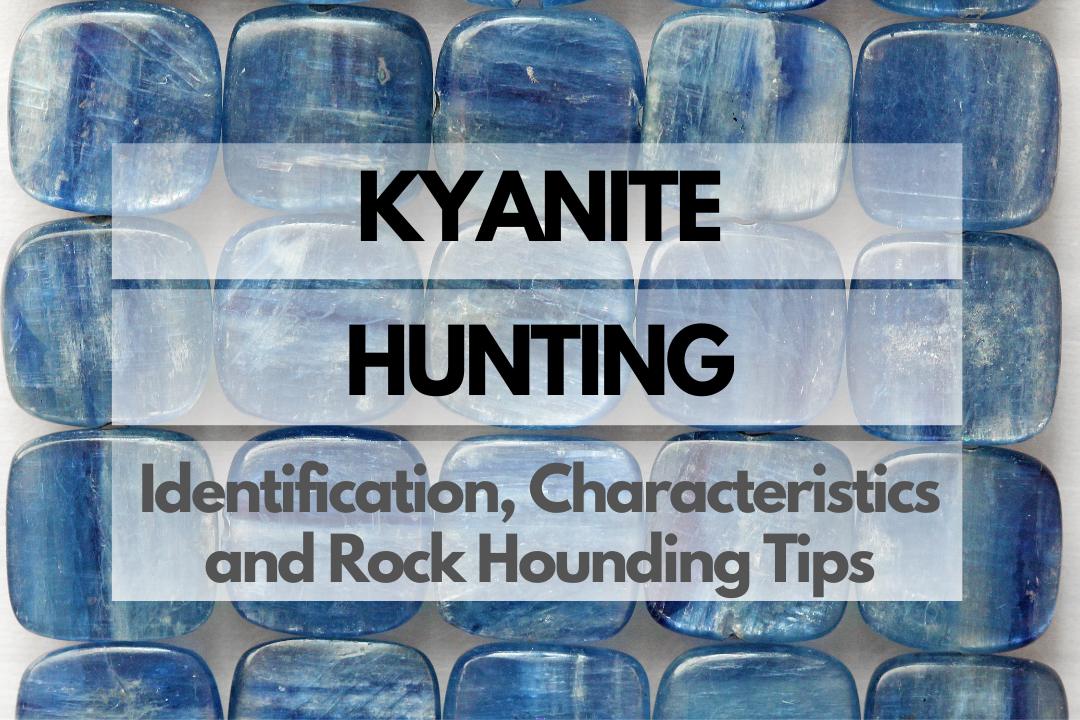There’s something incredibly alluring about the mesmerizing blue color and unique properties of kyanite crystals. Whether you’re a seasoned rock hound or brand new to the world of mineral exploration, this article will guide you through kyanite hunting, identification, characteristics, and rock hounding tips. So let’s dive in and uncover the fascinating world of kyanite!
History & Origin of Kyanite
Kyanite was first discovered in the early 19th century, with the name originating from the Greek word “kuanos,” meaning “deep blue.” This stunning mineral has held various cultural significances throughout history. In some ancient civilizations, kyanite was believed to possess healing and spiritual properties, such as promoting tranquility and enhancing communication. Today, kyanite is not only valued for its beauty but also its unique properties, making it an essential component in various industrial applications.
Kyanite Identification & Physical Properties
Before you embark on your kyanite hunting adventure, it’s essential to familiarize yourself with the physical properties of this captivating mineral. Here’s an HTML table with an overview of kyanite’s physical properties:
| Property | Description |
|---|---|
| Chemical Formula | Al2SiO5 |
| Crystal System | Triclinic |
| Cleavage | Perfect in one direction |
| Luster | Vitreous to pearly |
| Streak | White |
| Transparency | Transparent to translucent |
Kyanite Colors
While kyanite is most commonly associated with its striking blue color, it can also be found in various shades, including green, gray, white, and even black. The blue color in kyanite is due to the presence of trace amounts of iron and titanium. Color zoning, where a single crystal displays multiple colors, is also common in kyanite specimens.
Kyanite Hardness
One of the most distinguishing characteristics of kyanite is its unique variable hardness. Kyanite has a hardness of 4.5 to 5.5 on the Mohs scale when scratched along the crystal’s length, and a hardness of 6 to 7 when scratched across the crystal’s width. This unusual property is due to the crystal’s anisotropic structure, which means its properties vary depending on the direction of measurement.
Kyanite Types
While kyanite is mainly recognized for its blue variety, there are a few other types of kyanite that you might come across. Let’s explore some of these varieties:
Blue Kyanite
Blue kyanite is the most famous and sought-after variety, showcasing various shades of blue, from pale to deep azure. Prized for its beauty, blue kyanite is a popular choice for collectors and jewelry makers alike.
Green Kyanite
Green kyanite is less common than blue kyanite and is valued for its vibrant, emerald-green hue. This variety is believed by some to possess unique healing properties, such as promoting balance and emotional well-being.
Black Kyanite
Black kyanite, also known as “goosefoot kyanite” due to its distinctive fan-like crystal formations, is another variety of kyanite. Although not as well-known as blue or green kyanite, black kyanite is appreciated for its unique crystal structure and grounding properties.
Kyanite Uses
Kyanite has a variety of uses, ranging from decorative to industrial. Some common applications include:
- Jewelry making – kyanite’s vibrant colors and unique properties make it a popular choice for rings, pendants, earrings, and other jewelry pieces
- Collector’s specimens – kyanite’s striking appearance and rarity make it a prized addition to any mineral collection
- Industrial applications – kyanite’s heat resistance and stable expansion make it valuable in the manufacture of refractory materials, such as bricks, ceramics, and porcelain
- Metaphysical and healing practices – kyanite is believed by some to have a range of spiritual and healing properties, such as promoting tranquility, enhancing communication, and balancing energy
How Much Is Kyanite Worth?
The value of kyanite can vary greatly depending on factors such as color, clarity, size, and rarity. Generally, higher-quality blue kyanite specimens with intense color and good transparency can fetch anywhere from $50 to $500 per carat. More common, lower-quality specimens may be priced as low as a few dollars per carat. Rarer varieties, such as green kyanite, can sometimes command higher prices due to their scarcity. As with any mineral, the best way to determine kyanite’s value is to consult a reputable dealer or gemologist.
Kyanite Rock Hounding Tips
Now that you’re familiar with kyanite’s properties and characteristics, it’s time to learn some tips and tricks for a successful kyanite hunting adventure. In this section, we’ll cover essential tools and equipment, safety tips, and where to find kyanite around the world.
Essential Tools and Equipment
Equipping yourself with the right tools and gear can make all the difference when it comes to a successful kyanite hunting expedition. Here are some essential items to bring along:
- Rock hammer or geologist’s pick – to break open rocks and extract kyanite crystals
- Hand lens or magnifying glass – to inspect specimens up close and verify their properties
- Safety goggles – to protect your eyes from rock fragments
- Sturdy gloves – to protect your hands from sharp edges
- Backpack or collecting bag – to carry your finds, tools, and supplies
- Field guide or reference materials – to help with identification and location information
- First aid kit – for any unexpected injuries
- Water and snacks – to stay hydrated and energized
Safety Tips
Rock hounding can be a fun and rewarding activity, but it’s essential to prioritize safety. Here are some tips to keep in mind:
- Always wear appropriate safety gear, such as goggles, gloves, and sturdy shoes
- Be cautious when using tools like rock hammers, and make sure you have a secure grip
- Be aware of your surroundings and watch out for potential hazards, such as falling rocks or unstable terrain
- Never go rock hounding alone, and always let someone know your plans and expected return time
- Stay within your physical limits and don’t push yourself too hard
- Be respectful of private property and always obtain permission before hunting on someone else’s land
Kyanite Hunting: Where to Find Kyanite
Kyanite can be found in various locations around the world, with some regions being particularly well-known for their kyanite deposits. The best places to find kyanite are in metamorphic rocks, particularly those formed under high-pressure and low-temperature conditions. Here’s an HTML table detailing some specific sites and areas where you can find kyanite:
| Site/Area | Location |
|---|---|
| Yancy County | North Carolina, USA |
| Graves Mountain | Georgia, USA |
| Minas Gerais | Brazil |
| St. Gotthard | Switzerland |
| Zermatt | Switzerland |
| Kali Gandaki Gorge | Nepal |
Caring For Your Kyanite
Once you’ve found some beautiful kyanite specimens, it’s essential to care for them properly. Here are some tips to help you preserve and showcase your finds:
- Handle kyanite with care, as it can be fragile due to its perfect cleavage in one direction
- Clean your specimens gently with a soft brush and warm, soapy water to remove dirt and debris
- Store kyanite separately from other minerals, as it can be easily scratched by harder materials
- Display your kyanite in a safe location, away from direct sunlight and excessive moisture
Additional Resources
For further information and resources on kyanite and rock hounding, consider consulting the following:
- US Geological Survey (USGS) – https://www.usgs.gov/
- Mindat.org – https://www.mindat.org/
- Rock & Gem Magazine – https://www.rockngem.com/
- Local rock hounding clubs and communities – search online or in your area for groups with shared interests
- Books on rock hounding, mineral identification, and geology – available at local libraries and bookstores
Additional Kyanite FAQs
Here are some frequently asked questions about kyanite that we haven’t covered yet:
What are the benefits of kyanite?
Kyanite is a fascinating mineral with unique properties and characteristics that make it highly desirable for collectors. It can also be used in various industries, such as electronics, ceramics, and abrasives, thanks to its high alumina content and thermal stability.
Do kyanite have any healing properties?
While there is no scientific evidence to support the idea of kyanite having healing properties, some people believe that it can help with communication, self-expression, and emotional balance. As with any crystal or mineral, it’s essential to approach such claims with skepticism and rely on science-based methods for health and well-being.
Do kyanite have any spiritual meaning?
In some spiritual and metaphysical circles, kyanite is associated with enhancing communication, intuition, and psychic abilities. It is often used in meditation or energy work to help balance and align the chakras. Again, it’s important to keep in mind that these beliefs are not grounded in scientific evidence.
Do I need a permit to go kyanite hunting?
Permit requirements for rock hounding vary depending on the location and jurisdiction. In some cases, a permit may be required, particularly on public lands or in areas with specific mineral resources. To learn more about permit requirements in the United States, visit the Bureau of Land Management (BLM) website at https://www.blm.gov/.
Closing Thoughts
Armed with the knowledge and resources provided in this article, you’re well-prepared to embark on your own kyanite hunting adventure! Remember to prioritize safety and respect for the environment while you explore the world of rock hounding. With a little patience and persistence, you’ll soon be adding some stunning kyanite specimens to your collection. Happy hunting!

